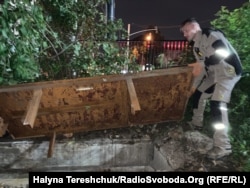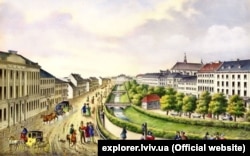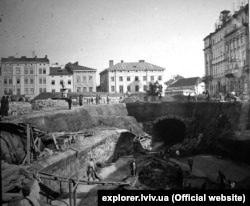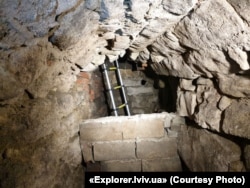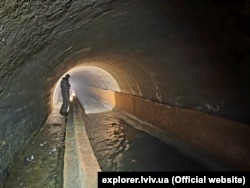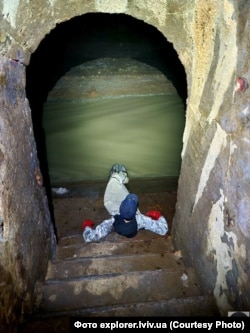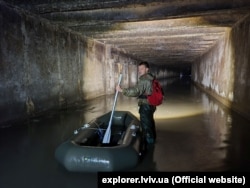After the discovery of a hideout dating from the Nazi occupation of Lviv, RFE/RL joined one of the urban explorers who are slowly uncovering the mysteries of Lviv's subterranean Poltva River.
For the past 13 years, Lviv local Andriy Ryshtun has been exploring the Poltva River, which was walled up and hidden under the western Ukrainian city in the 19th century.
The IT specialist carries a gas detector as he descends into the network of darkness beneath Lviv, taking us down the same watery path of the Jews who went into hiding here during the Second World War.
The Poltva River once ran in the open through the center of Lviv, but as the city's population grew, the narrow waterway became increasingly polluted. Beginning in 1839, the Austro-Hungarian authorities started channeling the Poltva into purpose-built underground tunnels that merged the river with Lviv’s sewage system.
Today, most visitors to famous landmarks such as the Lviv Theater of Opera and Ballet have no idea they are walking above a hidden river with a haunting history.
After the Nazi invasion of the Soviet Union in 1941, the dank tunnels of the Poltva River became a lifeline for hundreds of Jews fleeing the Nazi ghetto and mob violence meted out by some Ukrainians in Lviv.
In September 2021, local explorer Oleksandr Ivanov used the memoirs of a Holocaust survivor to locate the place where a group of Jews from the Lviv ghetto were hiding during the Nazi occupation. After a year of searching, the explorer uncovered a space cluttered with books, a bottle of German beer, and a heavily rusted electric flashlight, among other items.
The Jewish group had accessed the underground network by digging a tunnel from the ghetto created by Lviv's Nazi administration to the underground river created by Lviv's former Austro-Hungarian rulers.
According to a local historian, the desperate fugitives were discovered by sewer workers. Although the workers initially attempted to extort money from the group, they eventually began to help by delivering food. The group, including several children, were able to emerge from their hiding place when the Soviet Army captured Lviv in July 1944.
From around 160,000 Jews who lived in Lviv before the war, just 2,000 survived.
And the river holds other secrets. Ryshtun believes people used the river to hide during the height of Stalinist repressions during the 1930s.
“We’ve found coins of different periods, a silver spoon" he says. "Even ammunition was found recently, along with badly decayed weapons.”
Ryshtun first ventured into the river in 2008 and soon became a regular visitor to its tens of kilometers of tunnels and tributaries, sometimes spending as much as eight hours underground.
“It inspires me," he says. "The Poltva is huge. Even now, after all these years, I find feeder tunnels that I’ve never been in before. As well as the history, there’s a certain aesthetic to the place that is appealing.”
In one part of the tunnel, Ryshtun says there as a red brick section known as the "moon ceiling" by explorers. “When condensation shines in the light of our torches, it looks like twinkling stars,” he says.
A group of around 50 enthusiasts maintain a website and stay in regular contact about discoveries made under Lviv. But such exploring is not without risk. In waterways as narrow as the underground Poltva, even distant rainstorms can bring a sudden surge of water roaring through the urban river.
"If you follow all the rules, it is safe," Ryshtun claims. "In rainy weather, we don't go down. I haven't had a dangerous situation in 13 years. It is absolutely out of the question to go down alone or drunk. You need to behave with caution and everything will be fine."
The IT professional says he will continue his explorations of the river, parts of which he still has never ventured down.
"I am sure we still don't know all the secrets of the Poltva," he says.

